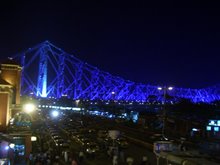Now, now ladies, all this hullabaloo about the Indian Government trying to sweep Gandhi's letters to a certain body-builder under the National Archives closet.
According to a new biography by Joseph Lelyveld, the love of Mahatma Gandhi’s life was a German-Jewish bodybuilder named Hermann Kallenbach. “Your portrait (the only one) stands on my mantelpiece in my bedroom,” Gandhi wrote to Kallenbach. “The mantelpiece is opposite to the bed.”
Well, here is what my good friend Paulie Rudnik had to say about Mr G in that excellent spoofie column of his in the New Yorker.I know that some people still don’t buy that Gandhi was gay, but let me tell you, from experience, Gandhi liked guys. I first met him when he came to see my ice show in Nepal, which was called “Holiday on Dirt.”
Gandhi came backstage and he told me, “I very much enjoyed watching you pretend to ice-skate, in your tight pants.” I asked him, “Um, so why are you wearing a diaper?” And he explained that his outfit was a traditional Indian dhoti, and I said, “Well, you look like the New Year’s baby.” And he said, “You are so handsome when you are not speaking.”
Then he told me about how he made the fabric for his dhoti himself, on his spinning wheel and hand loom, and I said, “Whoa, are you, like, a Native American lesbian?” And he said, “I will tell you over dinner.”
So we do the dinner thing, and he’s all, like, “I’ll just have a salad,” and I go, “Wait, are you some sort of total vegetarian whatever?” And he says yes, that he doesn’t believe in killing living things for food, and I’m, like, “Excuse me, but I’m gonna eat the cow before it eats me.” And Gandhi says, “You are the only grown man I have ever met whose first name is Kelly.” And I’m, like, “Well, your first name is Mohandas, right? Maybe you should change it, so that people can relate more. You could be, like, Tim Gandhi or Gary Gandhi.” And he goes, “Oh, Kelly.”
But he’s kinda cute, you know, in a legendary-world-leader sort of way, and he’s telling me all about his philosophy of nonviolence—I mean, on and on, blah blah blah, until I just want to smack him. And so I say, “O.K., so what if someone, like, punches you—are you just gonna sit there?” And he says, “Yes. What would you do?” And I say, “If someone punched me, I would throw my drink at them. I mean, maybe you should try that with the British.” And he says, “You are so very wise, perhaps you should spell your name Kellhi.”
And I think that’s totally adorable, so I say, “Let’s go back to your place,” and he tells me that he’s celibate. And I’m, like, “Huh? ’Scuse me?” And he says that he believes in the purity of the body and the soul, and that sometimes he sleeps beside a naked young woman, and does not become aroused. And I’m, like, “Me, too.” And then he says that also he’s married. And I’m thinking, Kelly, here we go again.
So I ask him if he’s come out to his parents, and he says, “Oh, no, they’re all old-school Hindu and they wouldn’t understand.” So I say, “But wouldn’t it be cool if you could do a campaign with a poster of your parents hugging you, and the poster could say, ‘Staying in the Closet Is a Hin-Don’t’?” And then he tells me about how India has this, like, totally bogus caste system, and how they even have people called untouchables, and I’m, like, “You mean brunettes?” And he laughs and I say, “No, it’s not funny. You mean, like, brunettes?” And he asks, “Kelly, have you ever studied any world history?,” and I’m, like, “Excuse me, but I happen to be wearing an imported Italian cashmere sweater,” and he says, “You know, maybe I’ll think about a steak.”
Of course, he eventually dumped me for this German-Jewish bodybuilder, and I warned him, I said, “Hello, been there, and I know that at first it sounds hot, but pretty soon it’s all ‘Nein, I can’t stay out late, because I have to get up early for the gym,’ and ‘Nein, we can’t do your rally for South Africa, because we’ve got my cousin’s Seder, remember?’ And his mother will be all ‘So, Mr. Gandhi, I’m told you like to lie down in front of railroad cars, to demonstrate a political point. Can you make a living from this?’ ”
But Gandhi and I stayed in touch, because he really was a good person. And he’d give me advice on guys and stuff. Like, he told me, “I know he’s cute, with the mustache and all, but Stalin is not for you.” But do I listen?












